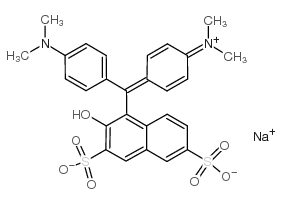酸性绿50

酸性绿50结构式

|
常用名 | 酸性绿50 | 英文名 | Green S |
|---|---|---|---|---|
| CAS号 | 3087-16-9 | 分子量 | 576.61600 | |
| 密度 | N/A | 沸点 | N/A | |
| 分子式 | C27H25N2NaO7S2 | 熔点 | N/A | |
| MSDS | 中文版 美版 | 闪点 | N/A | |
| 符号 |

GHS07 |
信号词 | Warning |
|
Comparative Genomics of Listeria Sensu Lato: Genus-Wide Differences in Evolutionary Dynamics and the Progressive Gain of Complex, Potentially Pathogenicity-Related Traits through Lateral Gene Transfer.
Genome Biol. Evol. 7 , 2154-72, (2015) Historically, genome-wide and molecular characterization of the genus Listeria has concentrated on the important human pathogen Listeria monocytogenes and a small number of closely related species, together termed Listeria sensu strictu. More recently, a numb... |
|
|
Electro-Fenton decolourisation of dyes in an airlift continuous reactor using iron alginate beads.
Environ. Sci. Pollut. Res. Int. 20(4) , 2252-61, (2013) In this study, electro-Fenton dye degradation was performed in an airlift continuous reactor configuration by harnessing the catalytic activity of Fe alginate gel beads. Electro-Fenton experiments were carried out in an airlift reactor with a working volume o... |
|
|
Decolourisation of dyes under electro-Fenton process using Fe alginate gel beads.
J. Hazard. Mater. 213-214 , 369-77, (2012) This study focuses on the application of electro-Fenton technique by use of catalytic activity of Fe alginate gel beads for the remediation of wastewater contaminated with synthetic dyes. The Fe alginate gel beads were evaluated for decolourisation of two typ... |
|
|
[Substances for staining biological tissues: use of dyes in ophthalmology].
Klin. Monbl. Augenheilkd. 222(4) , 309-11, (2005) The azo dye trypan blue and the cyanine dye indocyanine green have been used in ophthalmology since the 1980 s to dye the anterior capsule in cataract operations and to stain epiretinal membranes in order to remove the membrana limitans interna (ILM). By mean... |
|
|
PCR assessment of HSV-1 corneal infection in animals treated with rose bengal and lissamine green B.
Invest. Ophthalmol. Vis. Sci. 41(8) , 2096-102, (2000) In vivo, the ophthalmic dye rose bengal displays profound antiviral effects against herpes simplex virus (HSV)-1, thus limiting its utility in diagnosis of epithelial keratitis when used before viral culture is performed. In contrast, lissamine green B does n... |
|
|
A modified Schirmer test in dry eye and normal subjects: open versus closed eye and 1-minute versus 5-minute tests.
Cornea 29(4) , 384-7, (2010) To assess the results of 1-minute and 5-minute Schirmer test (ST) when eyes are open (STo) and closed (STc) in normal subjects and patients with dry eye disease.In a comparative, observational case series study, 34 normal volunteers (group 1) and 34 patients ... |
|
|
Purification of papain using reactive green 5 attached supermacroporous monolithic cryogel.
Appl. Biochem. Biotechnol. 167(3) , 552-63, (2012) Supermacroporous poly(2-hydroxyethyl methacrylate) [poly(HEMA)] monolithic cryogel was prepared by radical cryocopolymerization of HEMA with N,N'-methylene bisacrylamide as crosslinker. Reactive Green 5 dye was immobilized to the cryogel with nucleophilic sub... |
|
|
Staining characteristics of preserved human amniotic membrane.
Cornea 22(1) , 37-40, (2003) Amniotic membrane is an ultra-thin cellophane-like membrane that is used in ocular surface reconstruction. We evaluated the staining characteristics of commonly available dyes on preserved human amniotic membrane to aid in handling of amniotic membrane during... |
|
|
Insulin micropiles comprising biodegradable polymers for production of a long-term hypoglycemic effect.
J. Drug Target. 19(3) , 212-8, (2011) As a percutaneous sustained-release preparation, insulin micropiles (MPs) were prepared with biodegradable polymers poly(lactic acid) (PLA), poly(ϵ-caprolactone) (PCL) and poly(lactic-co-glycolic acid) (PLGA) as the base. The obtained PLA, PCL, and PLGA MPs o... |
|
|
Studies on the removal of Lissamine Green B from clays and soil in comparison with contemporary approaches.
J. Environ. Sci. Health. A. Tox. Hazard. Subst. Environ. Eng. 47(2) , 260-6, (2012) A combination of Fenton's reagent with electrochemistry has been demonstrated to be a efficient method for removing a dye (Lissamine Green B) from clays (kaolin, montmorillonite) and soil. The two-step approach described here involved quantitative extraction ... |